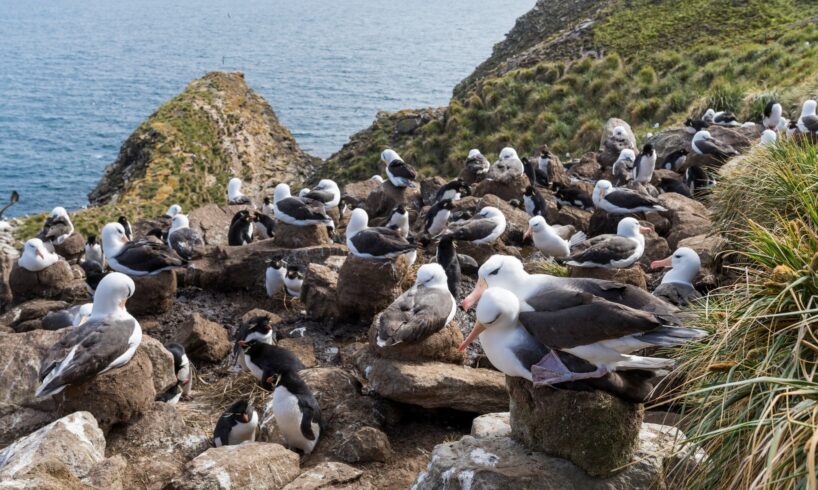
Not all relationships end in “happily ever after”, and birds are no exception. While more than 90% of bird species form monogamous couples, many of these will end in divorce.
The reasons for splitting up are as varied in birds as they are in humans, and often revolve around things like poor compatibility or slacking off by one partner. However, new research has found a surprising cause of divorce: climate change.
Like many seabirds, black-browed albatrosses form monogamous pairs that can last for the entirety of their 70-year lifespans. However, just under 4% of these couples will separate each year. Using data from 18 years of extensive observations, a team in the Falkland Islands have been digging into the reasons for divorce in birds of this species living there.
Environmental conditions profoundly affect animals’ survival and ability to breed successfully. As divorce often follows a bird couple’s failure to raise chicks, researchers imagined that in harsher environments – which could lead to lower breeding success – divorce might be more common.
The team focused on two environmental measurements. First, they looked at sea surface temperature anomalies, which occur when the annual temperature of the ocean’s surface changes significantly from a 30-year average value.
More anomalies indicate higher surface temperatures than normal. These increases in temperature make it difficult for organisms at the bottom of the food chain, like phytoplankton, to grow: meaning that less food is available for animals further up the food chain, like seabirds.
Second, the team examined wind speed. With their extraordinarily long wingspan that can reach up to 2.5 metres, albatrosses need strong winds to take flight and make their record-breaking migrations over the ocean. As a result, stronger wind currents benefit albatrosses, allowing them to fly long distances with relative ease.
Although the researchers found no effects to couples caused by wind, they did find that as temperature anomalies increase, so does the rate of divorce. In other words, the warmer the ocean, the less likely albatrosses were to stay with their mate.
Why do albatrosses separate?
Many animals that fail to breed in one year will divorce their partner in the next. Their logic is strategic: “I’ll stay with you if we’re successful in having children, and if not, I’ll try someone else”.
Albatrosses seem to use this approach when deciding whether to split up. Females whose eggs didn’t hatch were five times more likely to divorce their partner than those who raised a chick to fledging at four months old, or whose chicks died later on.
This makes sense. Eggs that don’t hatch probably indicate infertility or incompatibility between partners, whereas losing a chick is usually due to predation – an unlucky event that often isn’t your partner’s fault.
However, this study found that increases in temperature anomalies led to higher divorce rates above and beyond previous breeding problems. That means a female in a previously successful relationship, who would therefore be expected to stay with her partner, was much more likely to divorce her partner when sea surface temperatures were higher than normal. So what’s going on?
There are lots of reasons that environmental conditions could lead to divorce. Outside of breeding season, animals often migrate to regions where more food is available. There, they can rest and feed themselves in preparation for breeding.
When environmental conditions are poor, animals might take longer to find food and end up returning to the breeding colony late. This could make partners return home at different times, which could lead to divorce. For example, if a male’s partner arrives to the colony long before him, she may end up taken by someone else before the two have the chance to reunite.
Also, warm ocean conditions might make the divorce decision-making process malfunction. In normal conditions, if your partner is a lazy parent, you might end up picking up their slack by spending more time at your nest incubating eggs or feeding and protecting chicks. This might mean you divorce them in the following year to try your luck with someone more generous.
In years with warm oceans, albatrosses have to work harder to find food, and may end up injured or in ill health. The birds might mistakenly blame their partner for their own hardships – assuming that they are suffering because their partner isn’t pulling their weight to take care of their chick, rather than because the environment is sub-par.
Divorce can be beneficial for many animals, but also comes with drawbacks. For some seabirds, newly-formed couples are less successful at raising their chicks. If climate change increases divorce rates, this could reduce the number of new albatrosses making their way into the world, reducing the entire population size over time.
This research suggests we need to look more closely at whether these kind of climate-driven patterns pop up in the lives of other species, giving us much-needed insight into the many ways climate change is affecting those with which we share our planet.
This article was originally posted on Climate change is making monogamous albatrosses divorce – new research